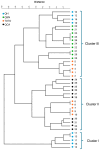Genetic Diversity and Conservation of Bomarea ovallei (Phil.) Ravenna: Microsatellite Markers Reveal Population Vulnerability in the Atacama Desert
- PMID: 40431033
- PMCID: PMC12115073
- DOI: 10.3390/plants14101468
Genetic Diversity and Conservation of Bomarea ovallei (Phil.) Ravenna: Microsatellite Markers Reveal Population Vulnerability in the Atacama Desert
Abstract
The Atacama Desert, the driest and oldest desert on Earth, hosts a unique floral phenomenon known as the Desierto Florido (Flowering Desert), which occurs sporadically in response to rare rainfall events. Bomarea ovallei (Phil.) Ravenna is an endemic and endangered species of the Atacama Desert. However, its populations are geographically restricted and potentially vulnerable to genetic erosion due to isolation and extreme environmental conditions. This study aims to assess the genetic diversity of B. ovallei populations and develop microsatellite markers using next-generation sequencing (NGS) technology. A total of 268 microsatellite loci were identified, and 34 co-dominant markers were successfully developed for the first time in B. ovallei. Genetic diversity analysis using eight fluorescently labeled SSR markers revealed low genetic diversity across four populations, with the highest diversity observed in the QCA population, located within Llanos de Challe National Park, and the lowest in the TOTO population, which is highly exposed to anthropogenic activities. UPGMA and STRUCTURE analyses revealed three genetic clusters and high admixture among populations, suggesting historical or ongoing gene flow despite geographical separation. The presence of non-polymorphic loci and low PIC values in some markers further supports limited genetic variation. The newly developed microsatellite markers offer a valuable tool for future genetic studies, enabling the monitoring of genetic diversity and informing strategies for the preservation of this rare and ecologically significant species.
Keywords: Bomarea genus; Flowering Desert; genetic diversity.
Conflict of interest statement
The authors declare no conflicts of interest.
Figures





Similar articles
-
Study on the characteristics of genetic diversity and population structure of a rare and endangered species of Rhododendron nymphaeoides (Ericaceae) based on microsatellite markers.BMC Plant Biol. 2025 Mar 11;25(1):310. doi: 10.1186/s12870-025-06362-8. BMC Plant Biol. 2025. PMID: 40069601 Free PMC article.
-
New microsatellites for the Atacama Desert endemic Balsamocarpon brevifolium (Fabaceae).Appl Plant Sci. 2019 Jun 11;7(6):e11271. doi: 10.1002/aps3.11271. eCollection 2019 Jun. Appl Plant Sci. 2019. PMID: 31236318 Free PMC article.
-
The development of 10 novel polymorphic microsatellite markers through next generation sequencing and a preliminary population genetic analysis for the endangered Glenelg spiny crayfish, Euastacus bispinosus.Mol Biol Rep. 2013 Jul;40(7):4415-9. doi: 10.1007/s11033-013-2531-5. Epub 2013 May 4. Mol Biol Rep. 2013. PMID: 23644985
-
Genetic diversity and population structure of the threatened chocolate mahseer (Neolissochilus hexagonolepis McClelland 1839) based on SSR markers: implications for conservation management in Northeast India.Mol Biol Rep. 2019 Oct;46(5):5237-5249. doi: 10.1007/s11033-019-04981-7. Epub 2019 Jul 19. Mol Biol Rep. 2019. PMID: 31325143
-
Conservation genetics of endangered medicinal plant Commiphora wightii in Indian Thar Desert.Gene. 2014 Feb 10;535(2):266-72. doi: 10.1016/j.gene.2013.11.018. Epub 2013 Dec 1. Gene. 2014. PMID: 24295888
References
-
- Clarke J.D.A. Antiquity of aridity in the Chilean Atacama Desert. Geomorphology. 2006;73:101–114. doi: 10.1016/j.geomorph.2005.06.008. - DOI
-
- Contreras R., van den Brink L., Sepúlveda B., Aguayo F., Porcile V. Phylogenetic relationships of plant species from the flowering desert of the Atacama Region. Bol. Latinoam. Caribe Plantas Med. Aromát. 2020;19:300–313.
-
- Gutiérrez J. El desierto Florido en la Región de Atacama. In: Squeo F., Arancio G., Gutiérrez J., editors. Libro Rojo de la Flora Nativa y de los Sitios Prioritarios Para su Conservación: Región de Atacama. Universidad de La Serena; La Serena, Chile: 2008. pp. 285–291.
-
- Squeo F., Arancio G., Gutiérrez J.R., Letelier L., Arroyo M.T.K., León-Lobos P., Rentería-Arrieta L. Flora Amenazada de la Región de Atacama y Estrategias Para Su Conservación. Universidad de La Serena; La Serena, Chile: 2008.
-
- Contreras-Díaz R., Huanca-Mamani W., van den Brink L., Fuentes M., Arias-Aburto M. The complete chloroplast genome of the endangered species garra de león [Bomarea ovallei (Phil.) Ravenna] from Chile. Indian J. Genet. Plant Breed. 2022;82:365–368. doi: 10.31742/ISGPB.82.3.14. - DOI
Grants and funding
LinkOut - more resources
Full Text Sources

